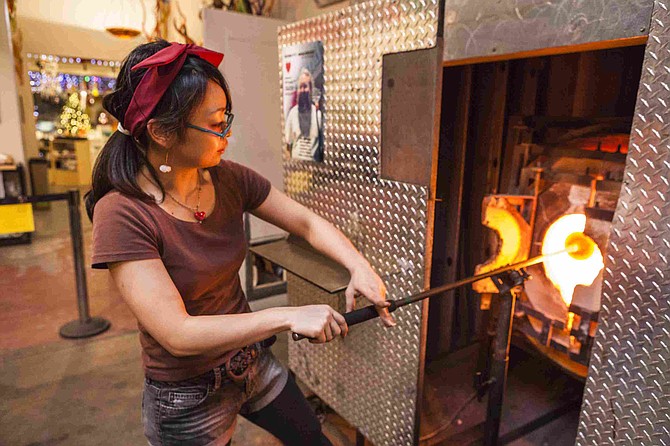Man this is a test!
None | 287Glassblowing is a glassforming technique that involves inflating molten glass into a bubble (or parison) with the aid of a blowpipe (or blow tube). A person who blows glass is called a glassblower, glassmith, or gaffer. A lampworker (often also called a glassblower or glassworker) manipulates glass with the use of a torch on a smaller scale, such as in producing precision laboratory glassware out of borosilicate glass.
As a novel glass forming technique created in the middle of the 1st century BC, glassblowing exploited a working property of glass that was previously unknown to glassworkers; inflation, which is the expansion of a molten blob of glass by introducing a small amount of air to it. That is based on the liquid structure of glass where the atoms are held together by strong chemical bonds in a disordered and random network,therefore molten glass is viscous enough to be blown and gradually hardens as it loses heat.
To increase the stiffness of the molten glass, which in turn facilitates the process of blowing, there was a subtle change in the composition of glass. With reference to their studies of the ancient glass assemblages from Sepphoris of Israel, Fischer and McCray postulated that the concentration of natron, which acts as flux in glass, is slightly lower in blown vessels than those manufactured by casting. Lower concentration of natron would have allowed the glass to be stiffer for blowing.
During blowing, thinner layers of glass cool faster than thicker ones and become more viscous than the thicker layers. That allows production of blown glass with uniform thickness instead of causing blow-through of the thinned layers.
A full range of glassblowing techniques was developed within decades of its invention.The two major methods of glassblowing are free-blowing and mold-blowing.
This method held a pre-eminent position in glassforming ever since its introduction in the middle of the 1st century BC until the late 19th century, and is still widely used nowadays as a glassforming technique, especially for artistic purposes. The process of free-blowing involves the blowing of short puffs of air into a molten portion of glass called a '"gather" which has been spooled at one end of the blowpipe. This has the effect of forming an elastic skin on the interior of the glass blob that matches the exterior skin caused by the removal of heat from the furnace. The glassworker can then quickly inflate the molten glass to a coherent blob and work it into a desired shape.
Researchers at the Toledo Museum of Art attempted to reconstruct the ancient free-blowing technique by using clay blowpipes. The result proved that short clay blowpipes of about 30–60 cm (12–24 in) facilitate free-blowing because they are simple to handle and to manipulate and can be re-used several times.[8] Skilled workers are capable of shaping almost any vessel forms by rotating the pipe, swinging it and controlling the temperature of the piece while they blow. They can produce a great variety of glass objects, ranging from drinking cups to window glass.
An outstanding example of the free-blowing technique is the Portland Vase, which is a cameo manufactured during the Roman period. An experiment was carried out by Gudenrath and Whitehouse[9] with the aim of re-creating the Portland Vase. A full amount of blue glass required for the body of the vase was gathered on the end of the blowpipe and was subsequently dipped into a pot of hot white glass. Inflation occurred when the glassworker blew the molten glass into a sphere which was then stretched or elongated into a vase with a layer of white glass overlying the blue body.
Mold-blowing was an alternative glassblowing method that came after the invention of free-blowing, during the first part of the second quarter of the 1st century AD.[10][11] A glob of molten glass is placed on the end of the blowpipe, and is then inflated into a wooden or metal carved mold. In that way, the shape and the texture of the bubble of glass is determined by the design on the interior of the mold rather than the skill of the glassworker.
Two types of molds, namely single-piece mold and multi-piece mold, are frequently used to produce mold-blown vessels. The former allows the finished glass object to be removed in one movement by pulling it upwards from the single-piece mold and is largely employed to produce tableware and utilitarian vessels for storage and transportation. Whereas the latter is made in multi-paneled mold segments that join together, thus permitting the development of more sophisticated surface modeling, texture and design.
The Roman leaf beaker which is now on display in the J. Paul Getty Museum was blown in a three-part mold decorated with the foliage relief frieze of four vertical plants. Meanwhile, Taylor and Hill tried to reproduce mold-blown vessels by using three-part molds made of different materials. The result suggested that metal molds, in particular bronze, are more effective in producing high-relief design on glass than plaster or wooden molds.
The development of the mold-blowing technique has enabled the speedy production of glass objects in large quantity, thus encouraging the mass production and widespread distribution of glass objects.


Comments
Use the comment form below to begin a discussion about this content.
Sign in to comment
Or login with:
OpenID